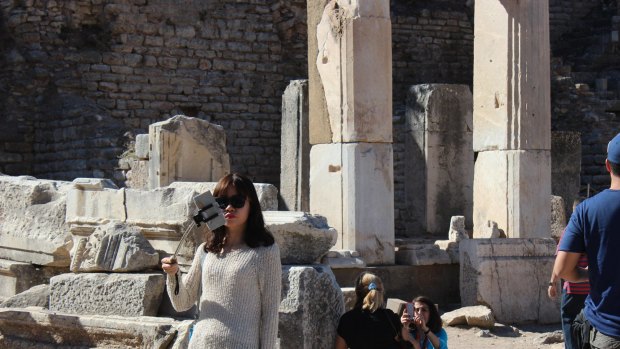By Ellen Creager

Tourists take selfies at Ephesus in Turkey.Credit: Alamy
This is one of the best preserved, loveliest and most historically significant Greco-Roman ruins in the world.
It also is a key religious spot, believed to be where the apostles Paul and John and Jesus' mother Mary all lived or spent time, and where the Gospel of John was written.
But in the age of the iPhone, all that seems like trifling history.
In the age of the iPhone, what seems to be the point of visiting here is taking pictures of yourself to post on Instagram to prove you had a super-amazing time in Turkey!
Jump on a 2,000-year-old marble column and strike a pose? No one stops you from doing it.
Carry around a "selfie stick" - a long pole with an iPhone attached? All the better to take photos of yourself tilting your head and smiling just so near a Roman column, which will appear as a distant blur behind your adorable face.
Recently I saw a group of gaily dressed tourists from China in Mickey Mouse shirts and floppy hats pose for pictures of themselves along nearly every step of Ephesus' marble streets.
I saw a girl taking a video of a cat, one of the many felines who live on the site, while ignoring the exquisite second century flowery marble pedestal the animal crouched on.
It could be that in its heyday, Ephesus would have been fine with the self-absorption of today's crowds.
(And we are talking about crowds: Turkey is on pace to break 2013's 2 million visitor record for Ephesus by about 10 per cent this year, due to 700 cruise ships docking at nearby Kusadasi and tourists arriving daily by bus, local officials reported recently.)
Ephesus, near the town of Selcuk, is the third most visited attraction in Turkey, after Istanbul's Hagia Sophia and Topkapi Palace.
Although it dates from about the 10th century BC and is reputedly named after an Amazon she-warrior, it was a Greek city worshiping the cult of Artemis, goddess of the hunt, for hundreds of years.
But by the first and second centuries under the Romans, Ephesus was a swinging place. It appreciated the finer things, like terraced homes and tile baths, wild animal fights and sophisticated ladies of the night. Its library had 12,000 scrolls. Its theater could seat 25,000. It was the cultural and trade center of the eastern Mediterranean.
Of course, nothing lasts.
In the last 2,000 years, Ephesus has survived sacking, pillaging, the complete silting-up of its harbor, earthquakes, destruction, oblivion and rediscovery.
It surely can survive 2 million personal electronic device-toting tourists each year.
I did eventually discover Yvonne Haywood of Maryland sitting quietly on a stone at Ephesus. She was gazing at the Library of Celsus, a stunning marble structure built in AD 125 that still impresses with its soaring dignity.
Haywood had no camera at all. She was just trying hard to imprint the scene in her memory.
"For me, recording the experience takes me out of that moment," she explained later.
But she's a modern person. She does not mind if others see the world through the lens of the iPhone. As long as they do not block her view.
MCT
Sign up for the Traveller Deals newsletter
Get exclusive travel deals delivered straight to your inbox. Sign up now.